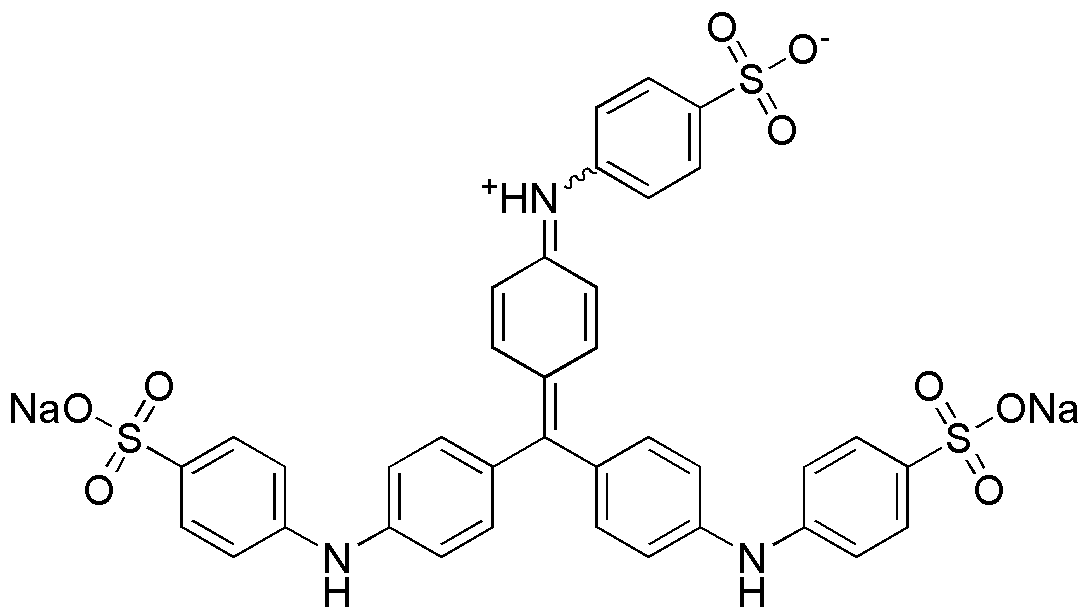Methyl blue is widely utilized in research focused on:
- Biological Staining: Commonly used as a dye in microbiology and histology to stain cells and tissues, enhancing visibility under a microscope. This application is crucial for identifying cellular structures and diagnosing diseases.
- pH Indicator: Acts as a pH indicator in various chemical experiments, changing color to signify acidic or basic conditions. This property is particularly beneficial in educational settings and laboratory experiments where monitoring pH is essential.
- Redox Reactions: Employed in redox titrations due to its ability to undergo color changes based on oxidation states. This makes it a valuable tool for chemists in quantitative analysis and determining the concentration of substances.
- Textile Industry: Used as a dye in the textile industry to color fabrics, providing vibrant shades. Its stability and ease of application make it a preferred choice for manufacturers looking for reliable coloring agents.
- Environmental Monitoring: Applied in assessing water quality, as it can indicate the presence of certain pollutants. This application is vital for environmental scientists and regulatory agencies focused on maintaining safe water standards.
Información general
Propiedades
Seguridad y normativas
Aplicaciones
Methyl blue is widely utilized in research focused on:
- Biological Staining: Commonly used as a dye in microbiology and histology to stain cells and tissues, enhancing visibility under a microscope. This application is crucial for identifying cellular structures and diagnosing diseases.
- pH Indicator: Acts as a pH indicator in various chemical experiments, changing color to signify acidic or basic conditions. This property is particularly beneficial in educational settings and laboratory experiments where monitoring pH is essential.
- Redox Reactions: Employed in redox titrations due to its ability to undergo color changes based on oxidation states. This makes it a valuable tool for chemists in quantitative analysis and determining the concentration of substances.
- Textile Industry: Used as a dye in the textile industry to color fabrics, providing vibrant shades. Its stability and ease of application make it a preferred choice for manufacturers looking for reliable coloring agents.
- Environmental Monitoring: Applied in assessing water quality, as it can indicate the presence of certain pollutants. This application is vital for environmental scientists and regulatory agencies focused on maintaining safe water standards.
Documentos
Hojas de datos de seguridad (HDS)
La SDS proporciona información de seguridad completa sobre la manipulación, el almacenamiento y la eliminación del producto.
Especificación del producto (PS)
La PS proporciona un desglose completo de las propiedades del producto, incluida la composición química, el estado físico, la pureza y los requisitos de almacenamiento. También detalla los rangos de calidad aceptables y las aplicaciones previstas del producto.
Certificados de análisis (COA)
Busque certificados de análisis (COA) ingresando el número de lote del producto. Los números de lote y de partida se pueden encontrar en la etiqueta de un producto después de las palabras "Lote" o "Lote".
Número de catálogo
Número de lote/lote
Certificados de origen (COO)
Este certificado de origen confirma el país en el que se fabricó el producto y también detalla los materiales y componentes utilizados en él y si se deriva de fuentes naturales, sintéticas u otras fuentes específicas. Este certificado puede ser necesario para cumplir con las normativas aduaneras, comerciales y regulatorias.
Número de catálogo
Número de lote/lote
Hojas de datos de seguridad (HDS)
La SDS proporciona información de seguridad completa sobre la manipulación, el almacenamiento y la eliminación del producto.
DownloadEspecificación del producto (PS)
La PS proporciona un desglose completo de las propiedades del producto, incluida la composición química, el estado físico, la pureza y los requisitos de almacenamiento. También detalla los rangos de calidad aceptables y las aplicaciones previstas del producto.
DownloadCertificados de análisis (COA)
Busque certificados de análisis (COA) ingresando el número de lote del producto. Los números de lote y de partida se pueden encontrar en la etiqueta de un producto después de las palabras "Lote" o "Lote".
Número de catálogo
Número de lote/lote
Certificados de origen (COO)
Este certificado de origen confirma el país en el que se fabricó el producto y también detalla los materiales y componentes utilizados en él y si se deriva de fuentes naturales, sintéticas u otras fuentes específicas. Este certificado puede ser necesario para cumplir con las normativas aduaneras, comerciales y regulatorias.


